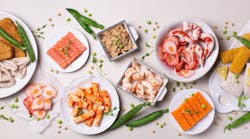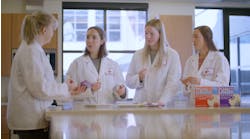Major food processors count on big R&D departments with labs around the world. Sophie’s Kitchen, which specializes in plant-based seafood, has demonstrated that even small R&D teams can accomplish a great deal. With just two researchers working on different ends of the country, Sophie’s Kitchen launched an entire product category in 2021.
“We created and launched six seafood burgers based on two different types: a whitefish burger and a salmon-style burger, with three different flavor SKUs each,” explains Lesley Werblin, one of the two researchers on the team. “We worked on them from concept all the way through production and commercialization.”
It took just six months for Werblin and her partner, Stephanie Laham, to get the fish burgers—Original Salmon, Spicy Salmon, Miso Salmon, Original Whitefish, Mango & Jalapeño Whitefish, and Mediterranean Whitefish—to market. But a short timeline was hardly the only challenge. Creating a fish-like product from plants requires innovations in texture, taste, look and scent. In addition, Sophie’s Kitchen fish burgers are soy-free, gluten-free, non-GMO and vegan.
Lesley Werblin
Sophie’s Kitchen has been making analogue seafood products for 12 years. Its products range from “toona” in a traditional 6-oz. can to fish and salmon fillets to crab cakes and breaded shrimp.
The fish burgers begin with a base of pea protein, which meets the soy- and gluten-free requirements. From there, the duo innovated with different ingredient formulations and processes.
“We really focused on making it taste and feel like a fish burger,” Werblin says. “It really needs to have the sensory experience of eating fish. That was the first hurdle. It has to look like what you're going to expect, feel like it, and then taste like it. So it's layering those things on top of each other, as well as working in fun but approachable flavor profiles that would be intriguing but not overwhelming for the consumer.”
Stephanie Laham
Getting the flavor right was a key challenge – consumers want their fish burgers to taste like fish, but not too “fishy.”
“You don't want it to smell like a fish market,” Werblin says. “That is unpleasant. So there's an interesting balance between the consumer expectation of fish flavor and the negative connotation with fish flavor. It's about finding the right balance of everything—flavor and salt and umami richness and the fattiness and herbs, all of that together.”
Processing the ingredients effectively—and in a fashion that could translate easily to the manufacturing stage – was even more important than the ingredients themselves, Werblin and Lanham say. They kept the factory floor in the front of their minds as they designed the burgers.
“We're using home kitchen equipment to mimic production equipment,” Werblin explains. “It's a little bit of a MacGyver kind of operation. ‘Oh, if I hold it this way, does it whip differently?’ or, ‘If I do it on the lowest speed for a longer time, does it turn out differently?’ ”
Werblin works from a rented kitchen space in the Seattle area and Laham works from home in Connecticut. Despite the distance separating them, collaboration comes easily, they say. They overcome the physical distance between them with technology.
“We spend a lot of time on video calls and shipping product back and forth,” Werblin says. “We work very closely with each other for feedback and guidance and direction. If one of us is stuck on a particular product, we'll switch it up, and the other may work on it for a little bit and then send some thoughts back. It's very flexible, which I think works really well for the types of projects we're working on.”
Adds Lanham: “We have very good working relationship, and we formulate in a very similar manner, which has allowed us to work so closely together and so successfully together.”
Their teamwork on the fish burgers has evidently paid off; the burgers are a hit with customers.
This is the third of our 2022 R&D Teams of the Year profiles. In July we profiled SunOpta, winner of the large-company category; Eat Just was featured in August, winning the medium-sized company category.
We pit teams against each other in those three size categories, putting their essays on a web-based poll this spring and asking our readers to choose the winners. 421 of you voted – thank you very much!
“When we do sales presentations, the most prevalent feedback is, ‘Wow, this is an actual fish burger. I feel like I’m eating fish,’” Laham says. “People don't believe this is a vegan product because it’s so similar to an actual salmon burger or a whitefish burger. We don’t want people to eat it and know that it’s vegan food. We want them to just enjoy delicious products that they can’t tell are vegan.”
The work that Laham and Werblin put into the fish burgers has also informed other projects. For example, they reformulated Sophie’s Kitchen’s legacy crab cake product and recently completed the first production run. More products will hit store shelves soon.
“There’s been so much innovation development that we’ve done, and it’s just a matter of when that final step will be taken to get them commercialized and launched,” Laham says. “We’ve put so much time and energy into figuring out what the consumer wants, what are the best ingredients to use and raw materials and processes. There’s just so much innovation happening in the vegan world right now that we’re really excited to be a part of it.”


